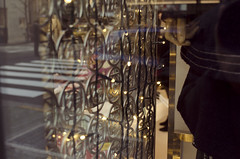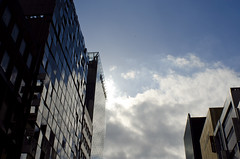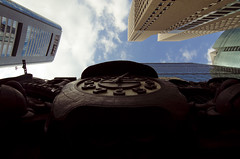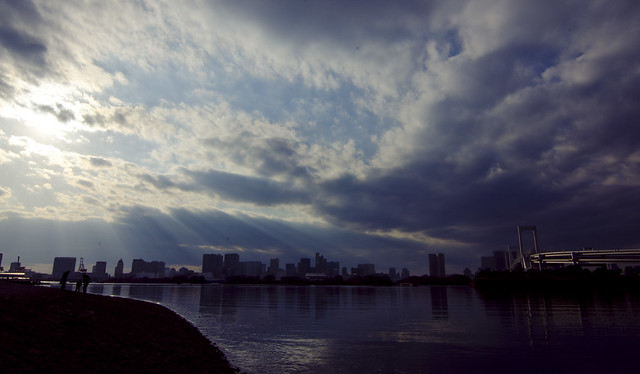I've had a hard time trying to get excited about going to the fancy shopping districts of Tokyo like Ginza (銀座) or Akihabara (秋葉原). I'd rather spend my time doing more romantic things like watching fingers of smoke curl from the tips of incense grope around the carved inlays of shrines, or taking contemplative strolls through the wrought landscapes of a samurai garden painstakingly manicured through time and discipline, or learning judo. I'm just not that interested in going to a district just to peer through the windows of shops whose average single-sale VAT totals outpace my monthly income.

Now, I'm not disinclined to shop. I mean, pretty much every Saturday that I find myself at Kashiwa no Ha Campus for the KIRA adult class I inevitably spend wandering through the halls of LaLaPort for two hours, walking in and out of Uniqlo or the Canteburry store, wafting through one patisserie and then another, or idly browsing through all seven home-goods gallery showrooms.
Actually, I find myself shopping for home goods an awful lot, which seems a bit decadent as the apartment Geoff and Mickie left me was fairly well furnished to begin with. But it seems that every week I come home with a new set of blankets or drapes
1 This is a point of annoyance. Even though I tend to spend a lot of time planning out what I want to buy, because I end up running in and out of the store so quickly, grabbing the first thing I see that remotely resembles what I intended to buy, I inevitably buy the "wrong thing." This happens with amazing consistency, and, as such, I now have two sets of drapes for my door because the first one I bought was half-too-short. That in addition to the two "blankets" that I bought, despite being clearly labeled as a "Blanket" only to find out later that, at Diaso, "blanket" means "futon cover" while at Muji it means "kotatsu cover."
1 (one set of drapes for the pair of sliding glass doors, one set for each window, and one to cover the stupid hollow steel front door).All that to say that I'm not against the idea of shopping. I'm just not going to plan my trips around the idea of "destination shopping."
That having been said, as I was so disappointed by my short stint in Akihabara in September that I was put off enough to put off going to Ginza for 6 months. Even then, having resolved to give Ginza a go, I had to fold it into a trip to Shinbashi (新橋) and Daiba (お台場) to make it palatable. At that, Ginza was barely interesting enough to warrant any mention at all.




That is neither here nor there as last weekend I found myself walking up and down Ginza
2 Mostly looking for the Nikon Showroom, which Google Maps completely whiffed on.
2 and south through Shinbashi and then into Odaiba, none of which I was especially interesting or exciting… Except Odaiba.Odaiba, itself, is--at least if you take a look at any map of Tokyo--pretty obviously a series of artificial islands; landfill pressed into squares and rectangles in the middle of Tokyo Bay. The name itself (台場, "daiba") means "fortress," and is derived from the six island fortresses constructed in the 1850s as Tokyo Bay's primary naval defense in response to the arrival of Commodore Perry's Black Ships3.
When Japan was demilitarized in the middle of the 20th Century, Odaiba was expanded to serve as a seaport district, with several of the fortress islands in Chuo, Koto and Minato connected using additional landfill. Then in the mid '90s, when the economy of Tokyo began to diversify and shipping expanded to other ports around Tokyo Bay, a major development plan was instituted by governor Shunichi Suzuki to repurpose much of the unused land as Tokyo Teleport Town, a showcase of Tokyo's commercial entertainment and residential future.
However, by the time the landfill project was finished in the mid-ninties--at an estimated cost of ¥1,000,000,000--the Japanese economy had collapsed, forcing many of the companies who had partnered with the local government to pull out, leaving much of the island undeveloped and disappointingly unpopulated. With progress stagnating and access to the island limited to one major bridge and three tunnels, Daiba became a bit of a commercial pariah as many larger companies found it a less than economical location to heavily invest, increasing the hesitancy of smaller business ventures.
Daiba remained somewhat underutilized until the early 21st century when a few companies like Telekomm and FujiTV took advantage of the the municipality's renewed interest in expanding Daiba's accessibility. Even today, despite the large amount of revitalization construction being done, much of Odaiba remains unrealized potential: the ether-substance of the dreams of ambitious politicians.
That being said, though, what is built there remains quite a spectacle. The iconic Rainbow Bridge that connects central Tokyo to the islands is an engineering icon. The ultra-modern Fuji Television Studios and the Telekom Center take up their residence there, as well as the new Tokyo International Exhibition Center ("Tokyo Big Sight"). Additionally, Daiba hosts both the Panasonic and Toyota showrooms and both the Maritime Museum and the Miraikan National Museum of Emerging Science and Innovation call Daiba home. Daiba also possesses one of Tokyo's two urban beach fronts, among countless large-scale super malls, shops and food courts.

The more I learn about Odaiba and it's "vision for the future," the more I realize how fitting a home it was for the life-size Gundam model back in 2009.
But this is neither here nor there, and despite the fact the few major tenants continue to maintain a strong and modern presence on this fantasy island, it is hard to ignore how unfulfilled and hapless the economic collapse has left Odaiba, which is, perhaps, a telltale sign of the current state of Japan, itself.
This, however, hasn't stopped the Tokyo municipalities from continuing to push through powerful and imaginative concepts based on the potential of Odaiba.
Little known fact: Tokyo put in a very serious bid to host the 2016 Olympics, which would have been a boon for the struggling metropolis. The plan was to use much of the currently unoccupied land in the outlaying islands of Odaiba for an Olympic complex. In an attempt to make this seem feasible, a number of large scale projects meant to improve the parts of Tokyo's infrastructure that ran with less-than-JR-levels of efficiency were undertaken, including the construction of a second major thoroughfare onto the islands from Tokyo.
This $1.4 billion project, which opens later this week, was started 10 years ago with the hopes that it would decrease the amount of time it would take most Tokyo-ites to get from Shin-Kiba (新木場), eastern Tokyo, to Odaiba (currently from 19 to 10 minutes), making Odaiba a more desirable destination for travelers, both domestic as well as those traveling internationally through nearby Haneda Airport, which would in turn attract commercial suitors for additional land development, thereby opening up the island for more populace uses, such as hosting an Olympic village.

The Tokyo Bay Bridge (dubbed "the Dinosaur Bridge") became the lead project in a sequence of major overhauls that targeted Tokyo's infamous traffic ails, receiving much of its present day funding in no small part because of the municipality's push for the 2016 Olympics. Ostensibly, with the 2016 Olympics going to Rio
4 Though shortlisted, Tokyo was eliminated in the second round of voting, finishing ahead only of Chicago.
4, all of the other building projects slated for Odaiba have been put on hold yet again.Admittedly, the projectis quite an amazing feat of engineering and ingenuity, spanning 1.6 miles and is reported to expect to carry 32,000 vehicles a day and so is still potentially useful for industry and travel, as the Port of Tokyo remains Japan's busiest port and will still link eastern Tokyo to the Haneda airport which, in 2010, began 24-hour flight services.
It is hard to criticize
5 Which has received criticism for being a literal "bridge to nowhere."
5 such bold attempts to stimulate the economy through grandiose building projects that aim to inspire and continue to look forward. But at a cost of around ¥95,000,000,000, and considering that the Japanese Olympic Bid Committee came up an additional ¥100,000,000 over budget for their failed 2016 bid, what is yet to be seen is whether or not the Dinosaur Bridge6 Along with the also impressive Sky Tree.
6 will be able to bear the burden of being another Tokyo-dream-project gone bust at the expense of the Japanese public, especially in this climate of austerity and government contraction. Or if the Tokyo Gate Bridge will ever eventually be able to span the distance between the Tokyo of today and Suzuki's dream of Tokyo's tomorrow.
Odaiba... featured prominently in the Digimon...
ReplyDelete